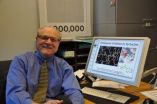Rewriting a receptor's role
Synaptic molecule works differently than thought; may mean new therapeutic targets for treating Alzheimer's disease
2013-02-20
(Press-News.org) In a pair of new papers, researchers at the University of California, San Diego School of Medicine and the Royal Netherlands Academy of Arts and Sciences upend a long-held view about the basic functioning of a key receptor molecule involved in signaling between neurons, and describe how a compound linked to Alzheimer's disease impacts that receptor and weakens synaptic connections between brain cells.
The findings are published in the Feb. 18 early edition of the Proceedings of the National Academy of Sciences.
Long the object of study, the NMDA receptor is located at neuronal synapses – the multitudinous junctions where brain cells trade electrical and chemical messages. In particular, NMDA receptors are ion channels activated by glutamate, a major "excitatory" neurotransmitter associated with cognition, learning and memory.
"NMDA receptors are well known to allow the passage of calcium ions into cells and thereby trigger biochemical signaling," said principal investigator Roberto Malinow, MD, PhD professor of neurosciences at UC San Diego School of Medicine.
The new research, however, indicates that NMDA receptors can also operate independent of calcium ions. "It turns upside down a view held for decades regarding how NMDA receptors function," said Malinow, who holds the Shiley-Marcos Endowed Chair in Alzheimer's Disease Research in Honor of Dr. Leon Thal (a renowned UC San Diego Alzheimer's disease researcher who died in a single-engine airplane crash in 2007).
Specifically, Malinow and colleagues found that glutamate binding to the NMDA receptor caused conformational changes in the receptor that ultimately resulted in a weakened synapse and impaired brain function.
They also found that beta amyloid – a peptide that comprises the neuron-killing plaques associated with Alzheimer's disease – causes the NMDA receptor to undergo conformational changes that also lead to the weakening of synapses.
"These new findings overturn commonly held views regarding synapses and potentially identify new targets in the treatment of Alzheimer's disease," said Malinow.
###
Co-authors on both papers are Helmut W. Kessels, Center for Neural Circuits and Behavior, Departments of Neuroscience and Biology, UCSD and Netherlands Institute for Neuroscience, Royal Academy of Arts and Sciences; and Sadegh Nabavi, Center for Neural Circuits and Behavior, Departments of Neuroscience and Biology, UC San Diego.
The research was funded in part by the National Institutes of Health (grants MH049159 and AG032132), the Shiley-Marcos Foundation, the Cure Alzheimer's Foundation, and the Internationale Stichting Alzheimer Onderzoek.
END
ELSE PRESS RELEASES FROM THIS DATE:
2013-02-20
BLOOMINGTON, Ind. -- Using a grown-up version of the rock-paper-scissors game, Indiana University cognitive scientists offer a new theory of the group dynamics that arise in situations as varied as cycles of fashion, fluctuations of financial markets, eBay bidding wars and political campaign strategies.
In a study written about this week in PLOS ONE, the researchers analyzed situations in which each person's decision depends on what they think other people will decide, looking at the riddle of "what you think I think you think I think."
What they found, said Seth Frey, ...
2013-02-20
RIVERSIDE, Calif. — Chemists at the University of California, Riverside have developed a compound that holds much promise in the laboratory in fighting renal (kidney) cancer.
Named TIR-199, the compound targets the "proteasome," a cellular complex in kidney cancer cells, similar to the way the drug bortezomib, approved by the Food and Drug Administration, targets and inhibits the proteasome in multiple myeloma cells, a cancer coming from bone marrow.
Michael Pirrung, a distinguished professor of chemistry at UC Riverside, announced the development of TIR-199 in a lecture ...
2013-02-20
VIDEO:
Scientists at the University of Montreal's Quebec Research Group in Animal Pharmacology have found a way to recognize and treat osteoarthritis in cats -- a condition that the owner might...
Click here for more information.
Scientists at the University of Montreal's Quebec Research Group in Animal Pharmacology have found a way to recognize and treat osteoarthritis in cats – a condition that the owner might not notice and that can make even petting painful. "Osteoarthritis ...
2013-02-20
If you want to read a mouse's mind, it takes some fluorescent protein and a tiny microscope implanted in the rodent's head.
Stanford scientists have demonstrated a technique for observing hundreds of neurons firing in the brain of a live mouse, in real time, and have linked that activity to long-term information storage. The unprecedented work could provide a useful tool for studying new therapies for neurodegenerative diseases such as Alzheimer's.
The researchers first used a gene therapy approach to cause the mouse's neurons to express a green fluorescent protein ...
2013-02-20
CAMBRIDGE, MA -- Understanding exactly how droplets and bubbles stick to surfaces — everything from dew on blades of grass to the water droplets that form on condensing coils after steam drives a turbine in a power plant — is a "100-year-old problem" that has eluded experimental answers, says MIT's Kripa Varanasi. Furthermore, it's a question with implications for everything from how to improve power-plant efficiency to how to reduce fogging on windshields.
Now this longstanding problem has finally been licked, Varanasi says, in research he conducted with graduate student ...
2013-02-20
There are "things hidden in plain sight" all around us. But art can help students see their world anew, unlocking discoveries in fields ranging from plant biology to biomedical imaging, according to University of Delaware professor John Jungck.
Jungck's sentiments were echoed by a panel of experts speaking on "Artful Science" on Feb. 15 at the annual meeting of the American Association for the Advancement of Science (AAAS) in Boston. Jungck organized the panel and also spoke at the event.
Canoeing on a lake near his home in northwestern Minnesota when he was a youngster, ...
2013-02-20
Would you prefer $120 today or $154 in one year? Your answer may depend on how powerful you feel, according to new research in Psychological Science, a journal of the Association for Psychological Science.
Many people tend to forego the larger reward and opt for the $120 now, a phenomenon known as temporal discounting. But research conducted by Priyanka Joshi and Nathanael Fast of the University of Southern California Marshall School of Business suggests that people who feel powerful are more likely to wait for the bigger reward, in part because they feel a stronger connection ...
2013-02-20
BOSTON -- Models of the human brain, patterned on engineering control theory, may some day help researchers control such neurological diseases as epilepsy, Parkinson's and migraines, according to a Penn State researcher who is using mathematical models of neuron networks from which more complex brain models emerge.
"The dual concepts of observability and controlability have been considered one of the most important developments in mathematics of the 20th century," said Steven J. Schiff, the Brush Chair Professor of Engineering and director of the Penn State Center for ...
2013-02-20
UNIVERSITY PARK, Pa. – Identifying areas of malarial infection risk depends more on daily temperature variation than on the average monthly temperatures, according to a team of researchers, who believe that their results may also apply to environmentally temperature-dependent organisms other than the malaria parasite.
"Temperature is a key driver of several of the essential mosquito and parasite life history traits that combine to determine transmission intensity, including mosquito development rate, biting rate, development rate and survival of the parasite within the ...
2013-02-20
Species facing widespread and rapid environmental changes can sometimes evolve quickly enough to dodge the extinction bullet. Populations of disease-causing bacteria evolve, for example, as doctors flood their "environment," the human body, with antibiotics. Insects, animals and plants can make evolutionary adaptations in response to pesticides, heavy metals and overfishing.
Previous studies have shown that the more gradual the change, the better the chances for "evolutionary rescue" – the process of mutations occurring fast enough to allow a population to avoid extinction ...
LAST 30 PRESS RELEASES:
[Press-News.org] Rewriting a receptor's role
Synaptic molecule works differently than thought; may mean new therapeutic targets for treating Alzheimer's disease




